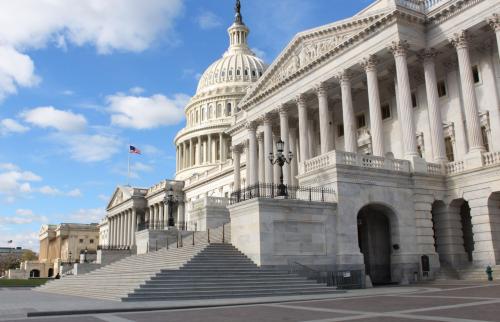The House-passed One Big, Beautiful Bill Act (OBBBA) is estimated to increase the budget deficit by roughly $2.5 trillion over the next decade. The speaker of the House suggests that, in reality, the bill will not actually increase the deficit and that the Congressional Budget Office (CBO) is not giving the bill credit for the “extraordinary growth” it will produce. But, although the bill would raise growth, the effect would be modest.
In principle, a well-designed tax cut can increase the size of the economy: It gives people more money to spend and improves incentives to work, save, invest, and take risks. However, these positive effects can be offset by the negative effects of additional federal borrowing and responses by the Federal Reserve.
The OBBBA extends, expands, and makes permanent the income tax and estate tax provisions of the Tax Cuts and Jobs Act (TCJA) of 2017. It temporarily restores some of the business tax cuts, introduces temporary versions of some of President Trump’s campaign proposals, and has several “pay-fors” that target immigrants, universities, health care, low-income households, and inbound foreign investment.
Multiple analyses of the bill’s provisions project modest effects on growth
The Joint Committee on Taxation estimates that gross domestic product (GDP) will be higher by 0.4% over 10 years under OBBB and that investment will fall slightly. The Tax Foundation estimates that GDP will be 0.8% higher after 30 years and that the capital stock will rise by 0.2%. The Penn Wharton Budget Model finds a similar effect on GDP of 0.7% after 30 years, with a 1.5% rise in the capital stock.
These modest projections make sense. Although the bill would extend the lower statutory tax rates, improving incentives to work and invest, several other features would work in the opposite direction. Higher taxes on homeowner-occupied housing and corporate investment and higher federal borrowing would reduce investment. Furthermore, the temporary nature of the expensing provisions means they will not produce any growth in the long run.
On top of that, the three estimates above may overestimate the economic benefits of the bill and Trump’s broader economic agenda. The Tax Foundation’s estimate, for example, excludes the impact of retaliatory taxes on inbound investment, which would reduce GDP. All three estimates omit the negative impact of reduced immigration and trade tensions. Separately, the Tax Foundation estimates that if President Trump’s tariffs stay in place, it would reduce output by 0.8%, entirely offsetting the OBBBA’s impact on output.
In contrast, the White House Council of Economic Advisors (CEA) finds the bill would produce significant economic growth. CEA projects the bill would increase GDP by up to 3.5%, raise investment by up to 7.5%, and raise wages by up to $11,600 per worker. They also argue that the OBBBA would boost the economy by up to 5.2% in the first few years after enactment.
The CEA’s outlier results prompt skepticism
First, the CEA did not analyze provisions of the OBBBA. It assumes the bill’s temporary expensing provisions are permanent, which accounts for roughly 40% of CEA’s long-run projected investment response and 20% of their long-run projected GDP response.
In addition, CEA assumes provisions that the bill does not include: a special lower tax rate on manufacturing income and an additional rate cut in the foreign derived intangible income (FDII) provision.
Second, the CEA incompletely or incorrectly models several provisions. Here are two examples.
- The CEA models individual income tax provisions but accounts only for the effects of lower marginal tax rates on work. They do not account for the negative effect of fewer taxpayers taking the state and local tax (SALT) and home mortgage interest deductions on the cost of homeowner occupied housing relative to current law.
- The CEA assumes the bill’s foreign derived intangible income (FDII) and global intangible low-tax income (GILTI) provisions, like its corporate rate cuts, would increase U.S. investment. But GILTI does not change the cost of investing in the US. It applies to foreign profits of U.S. multinational corporations. FDII can discourage investment in tangible U.S. assets because if a firm builds another factory in the U.S., it would shrink the share of income that qualifies for the lower FDII rate.
In an April analysis, the CEA argues their modeling is accurate because their 2017 projections of the TCJA were correct. In 2017, they projected an increase in long-run GDP growth between 2 and 4% and a $4,000 boost to per-worker wages. They claim that macroeconomic data validate these projections and show that real GDP was 2.5% higher than CBO’s pre-TCJA baseline and real wages increased by $4,992 per worker.
In contrast to the CEA claims, the macroeconomic effects of the TCJA were far less obvious than they suggest. While GDP rose relative to CBO’s projections following the passage of the TCJA, the TCJA was not the only policy at the time that positively impacted the economy.
Furthermore, growth in output was relatively flat between the eight quarters before and after the passage of the TCJA. Likewise, macroeconomic data does not show an obvious increase in wages. Growth in real median earnings for wage and salary employees rose by 0.09 percentage points after the TCJA.
While some more recent causal papers show positive effects on corporate investment, they do not support the magnitudes implied by CEA’s claims. Macroeconomic data suggest that overall investment in two assets the TCJA targeted, equipment and structures, barely budged after 2017.
As the OBBBA moves through the Senate, lawmakers should be realistic about how this legislation will impact the economy. While most groups agree that it will have an impact, the bill’s provisions indicate that effects will be modest at best. And those modest effects will be swamped by its significant negative impact on the federal government’s finances.
The Brookings Institution is committed to quality, independence, and impact.
We are supported by a diverse array of funders. In line with our values and policies, each Brookings publication represents the sole views of its author(s).








Commentary
Don’t expect much growth from the One Big, Beautiful Bill
June 10, 2025